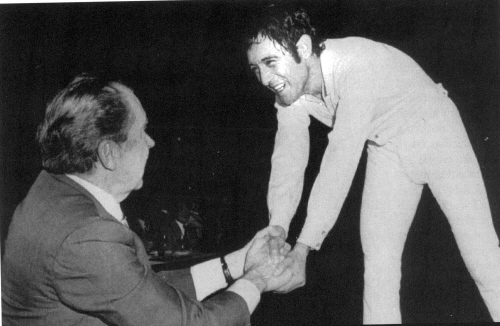
President Nixon greets his favorite juggler at the Lido. |
Page 22 Summer 1995
|
My
first time in Las Vegas was 1948 when I was at the Flamingo Inn for
the Lido show for 12 months. It was the last hotel on the Strip, and
was so far away from anything that we never had more than 10-12 people
in the house. In the Frontier, where I worked also, there was a small
stage surrounded by tables. They'd have a name, two variety acts and a
line of girls. That was it.
There
was nothing in Las Vegas then, only three or four casinos on the strip
- The Last Frontier and the Rancho, and later on the
The
first big show I remember was the four weeks I spent opening Frank
Sennes's Minsky Show at Wilbur Clark's Desert Inn. Everyone thought it
was crazy because it had strip tease! It actually caused a sensation,
and people from California came in from all over to see it.
I
started doing my 14-minute full act when I started doing just two
shows a day in Reno and Las Vegas. It was easier to do a long act than
so many shows. I still warmed up for two or three hours, and practiced
the spots in the routine where something went wrong.
One
of the things in my act was tricks while I jumped rope. First I jumped
a small rope in time to the music, changing to a big rope, and jumped
it while I bounced a ball on my head. Then while jumping I stopped it
and rolled it in circles around my head. I caught it on the back of my
neck, threw it high and jumped the rope again.
I
was the first to do the three ball spin - one on each finger and one
on a mouthstick and do a back roll-over. In the last couple of years I
did two roll-overs. That's difficult because you have to do the second
turn very fast or the balls will stop. I can't do that one any more,
though, because of my bad leg.
For
a long time I did seven balls with billiard pockets. For a finale,
when all seven were coming down I would catch the first six
I
went to six balls later because it was slower and more sure.
I
was a very famous child juggler in South America, but when I came to
America I couldn't speak English at all. But I was friendly with
Another
big shock was taxes. When I arrived in Miami I had $14,000 in
travelers checks. That was a lot of money. Then at the end of the year
they told me about taxes. I had never in my life heard of taxes. So I
went to an accountant and he told me he needed to consult with someone
in the IRS. They decided I had not made enough money that entire year
to pay what l owed the government!
It
was because I had no residence anywhere in the America. We used to
travel every single day, and since I had no residence, I had no rights
to deduct any of my expenses. And in those first years I was making an
awful lot of money, about $750-$1,000 a week, with extra pay after
five shows and it wasn't unusual to do seven!
The
IRS said they were going to sue me. But one of the heads of Paramount
said he had a
After
that I declared a residence with a friend, and from that moment on it
was much better. But my first two years when I lived in the theatre
were terrible. The third year my company said they had a gift for me,
and gave me a Lincoln automobile. Where I came from, though, no one
had a car! The only people who had cars were professional drivers. I
had never driven in my life, and with all the traffic here I didn't
want to learn. I told them I didn't want it and they sold it.
The
first time I worked with the Harlem Globetrotters
Then
I went back home and worked for the Paramount again, working a lot
with Frankie Laine. They sold the Frankie Laine show to the Palladium
theatre in London in 1957. They weren't anxious to have to me because
they said there were so many jugglers there. But I ended up being on
the front page of three newspapers, and got standing ovations even
from the orchestra.
When
I arrived in the u.s. I was very good, but I needed something else.
The key to my success came in Cincinnati at the Beverly Hills Club,
where I worked with producer Don Arden. We became friends, and when we
were working in Vegas later he said to me one time after rehearsal,
"Rudy, may I talk to you?" I said "Sure." He said,
"Sit down. You know Rudy, when you do something, do it two or
three times, not more than that. You lose the sensation of moving from
one thing to another. If they see it once or twice is enough."
I
was so mad with him I could kill him. But I practiced like that and
before you knew it it made a tremendous difference. Rene Friday, the
head of the lido, told me one time when we went out to see a juggling
competition, Why do jugglers think that just because they juggle one
more hoop or ball it will make any |

President Nixon greets his favorite juggler at the Lido. |